
1995 BMW R100 GS PD
The Paris Dakar Rally Pays Off
for BMW
Cifu
Motorsports Home / Motorcycles / BMW R100GS/PD
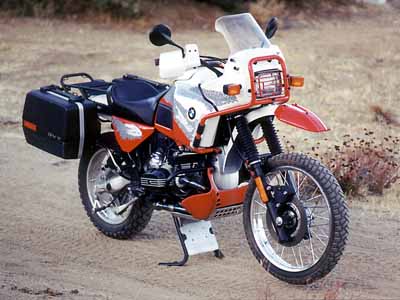 In the 1980, BMW began an unlikely
assosiation with the Paris Dakar Rally.
At that time, the then 2 year old rally had been dominated by some
rather uncommon machines: hand prepared BMW Airhead boxers. The demands
of the Sahara were too great for the average dirt bike of the time.
What was needed to win was a stone reliable machine with great range.
To answer that question, teams prepared motorcycles that were largely
stock, right down to their factory Bing or Dellorto carburetors. Yes,
they ran more efficient air cleaners and open exhausts but power does
not win Dakar, reliability and consistent performance does. The frames
were reinforced, swingarms were lengthened and long travel shocks
installed. The best forks and brakes of the day were pulled from KTM
motocross bikes and installed on the BMW desert sleds. To finish the
machine off, huge fuel tanks were fitted. Some of these hand hammered
aluminum tanks held more than 11 gallons (US) of fuel. Of course the
well known BMW shaft drive was largely impervious to the 5000+ miles of
sand each machine would face. Yes, it was heavy but it was stone
reliable and easy to maintain and that's what it took to win Dakar.
Gaston Rahier and others rode these beasts to win after win. Yes, other
bikes were faster or lighter but in the end, the reliability and the
comfortable pace maintained by the BMW's eventually dominated.
In the 1980, BMW began an unlikely
assosiation with the Paris Dakar Rally.
At that time, the then 2 year old rally had been dominated by some
rather uncommon machines: hand prepared BMW Airhead boxers. The demands
of the Sahara were too great for the average dirt bike of the time.
What was needed to win was a stone reliable machine with great range.
To answer that question, teams prepared motorcycles that were largely
stock, right down to their factory Bing or Dellorto carburetors. Yes,
they ran more efficient air cleaners and open exhausts but power does
not win Dakar, reliability and consistent performance does. The frames
were reinforced, swingarms were lengthened and long travel shocks
installed. The best forks and brakes of the day were pulled from KTM
motocross bikes and installed on the BMW desert sleds. To finish the
machine off, huge fuel tanks were fitted. Some of these hand hammered
aluminum tanks held more than 11 gallons (US) of fuel. Of course the
well known BMW shaft drive was largely impervious to the 5000+ miles of
sand each machine would face. Yes, it was heavy but it was stone
reliable and easy to maintain and that's what it took to win Dakar.
Gaston Rahier and others rode these beasts to win after win. Yes, other
bikes were faster or lighter but in the end, the reliability and the
comfortable pace maintained by the BMW's eventually dominated.
BMW Accidentally Creates a New Genre of Motorcycling
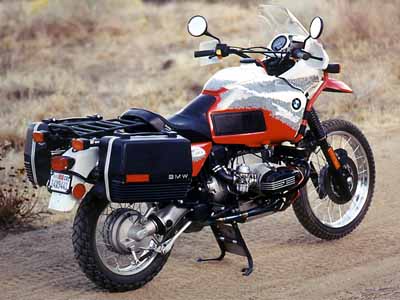 To celebrate this achievement, BMW built Paris
Dakar commemoritave
bikes beginning in 1981. Labled the BMW R80GS, the bike featured white
paint and a color scheme strangely reminescent of the rally bikes. It
was basically a doctored R80 with longer travel suspension and high
fenders. It also featured an uncommon feature for the day: a single
sided swingarm. Labled the "MonoLever" it housed the ring & pinion
in the right side of the swingarm. On the opposite side of the wheel,
three lug bolts secured the wheel to the ring gear. The GS didn't
really offer more fuel capacity or serious off-road capability but just
as the 1975 GL1000 Gold Wing accidentally became the touring standard,
the little GS invented a new segment of the market previously ignored:
Adventure Touring. Imagine touring for days on paved roads, only to see
a gravel road meanering off into the mountains--a gravel road you don't
dare take your plastic wrapped touring barge onto. That's the market
the R80GS was destined to dominate.
To celebrate this achievement, BMW built Paris
Dakar commemoritave
bikes beginning in 1981. Labled the BMW R80GS, the bike featured white
paint and a color scheme strangely reminescent of the rally bikes. It
was basically a doctored R80 with longer travel suspension and high
fenders. It also featured an uncommon feature for the day: a single
sided swingarm. Labled the "MonoLever" it housed the ring & pinion
in the right side of the swingarm. On the opposite side of the wheel,
three lug bolts secured the wheel to the ring gear. The GS didn't
really offer more fuel capacity or serious off-road capability but just
as the 1975 GL1000 Gold Wing accidentally became the touring standard,
the little GS invented a new segment of the market previously ignored:
Adventure Touring. Imagine touring for days on paved roads, only to see
a gravel road meanering off into the mountains--a gravel road you don't
dare take your plastic wrapped touring barge onto. That's the market
the R80GS was destined to dominate.
The BMW R80 GS enjoyed a small but rabidly enthusiastic and growing
market. It continued largely unaltered from 1981 through 1987. In 1988,
the machine recieved its first major revamp becoming the R100GS. We
have a "Bumblebeemer" example of the 1988 model year here. The 1988 upgrade included a
displacement bump from 800 to a full 1000cc's. The 800cc displacement
was still available outside the United States albeit, with the newer
chassis and styling. The new bike featured longer travel, stiffer front
forks and another upgrade to the rear suspension, becoming the
Paralever. This new system floated the ring & pinion housing with a
torque arm, virtually eliminating the characteristic shaft drive
pogo-effect while transitioning the throttle. This bike inched closer
still to the BMW rally bikes that had also enjoyed continued success
over in Africa.
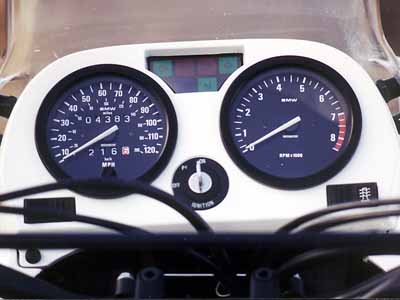 1990 was to see the introduction of an official
"Paris Dakar"
conversion kit. This kit included a 9.0 gallon nylon fuel tank, a steel
'roo-bar' around a new fixed headlight assembly and instrument cluster
with tachometer. Underneath, larger, vented skid plates attached to
both the engine and the centerstand. A plastic fender
extension--looking every bit like a childs sand shovel--added length to
the front fender. Later in 1990, BMW began offering the 'kit' on
factory motorcycles and labled it the R100GS/Paris Dakar. The factory
bikes also included the factory BMW hard bags as standard equpment, as
well as heated grips.
1990 was to see the introduction of an official
"Paris Dakar"
conversion kit. This kit included a 9.0 gallon nylon fuel tank, a steel
'roo-bar' around a new fixed headlight assembly and instrument cluster
with tachometer. Underneath, larger, vented skid plates attached to
both the engine and the centerstand. A plastic fender
extension--looking every bit like a childs sand shovel--added length to
the front fender. Later in 1990, BMW began offering the 'kit' on
factory motorcycles and labled it the R100GS/Paris Dakar. The factory
bikes also included the factory BMW hard bags as standard equpment, as
well as heated grips.
I vividly remember reading Bill Stermer's article in 1990 reviewing the
new machine, as well as Clement Salvadori's awesome trip through
Engineer Pass in Colorado. You didn't have to be a fan of the Paris
Dakar Rally to see why this bike was so alluring. With its plush, long
travel suspension, honest 300 mile range (before you start LOOKING for
gas) and factory hard luggage, the big boxer quickly became a favorite
among street-going BMW fanatics. Never mind taking it off road, this
was a GREAT road bike. It quickly became one of BMW's best selling models
and to this day, it is often argued to be the very best all-around
Airhead BMW ever made. In later years, the Paris Dakar name had to be
dropped due to licensing issues with the rally organizers so it was
simply shortened to PD.
Getting My Own Paris Dakar
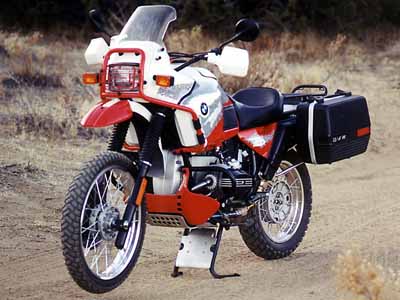 And so it was that the year 2000 was to find my
beloved 1988 R100GS twisted up
in the
garage: the victim of "turned left in from the motorcycle
and never saw him coming." Yes, after lovingly putting my Bumblebeemer
back on the road and literally one week from her maiden voyage to Death
Valley, she was totalled. I didn't fare much better, suffering a
shattered ankle, banged up wrist, bruised ribs and an assortment of
other battle scars. The morning after the accident, I was on the phone
trying to find a Dakar conversion kit. I was determined to rebuild the
Bumblebeemer to better than new. After much searching, I had to concede
that no kits were available. The gas tanks had been long-since been
bought up by owners wishing to convert their standard model GS's to
PD's. Since the last PD rolled off the assembly line in 1995, it was
unlikely that spares were still floating around.
And so it was that the year 2000 was to find my
beloved 1988 R100GS twisted up
in the
garage: the victim of "turned left in from the motorcycle
and never saw him coming." Yes, after lovingly putting my Bumblebeemer
back on the road and literally one week from her maiden voyage to Death
Valley, she was totalled. I didn't fare much better, suffering a
shattered ankle, banged up wrist, bruised ribs and an assortment of
other battle scars. The morning after the accident, I was on the phone
trying to find a Dakar conversion kit. I was determined to rebuild the
Bumblebeemer to better than new. After much searching, I had to concede
that no kits were available. The gas tanks had been long-since been
bought up by owners wishing to convert their standard model GS's to
PD's. Since the last PD rolled off the assembly line in 1995, it was
unlikely that spares were still floating around.
All through my recovery, the search for a used motorcycle or kit
continued. My ideal bike would have been a 1995 (the last year), red
and white (any real Dakar fan has to have Gaston Rahier, Marlboro
colors) and of course it would be new. Fat chance five years later,
right? Wrong. After six months and just before I was to give up finding
a clean one, an ad was found online for a 1995 BMW R100GS/PD in Park
City, Utah. One owner, low miles...746 miles? SEVEN HUNDRED AND FORTY
SIX? I must have read wrong. No, after contacting the owner, it was in
fact, a virtually new, five year old motorcycle. Unbelievably, it
already had a Corbin seat but was otherwise unmolested and flawless.
After a few emails back and forth negotiating the price, he sent this:
"Look, I've got two people interested
in this bike, you and a guy in Oregon. The first guy to show up at my
door with $7,800 gets the bike."
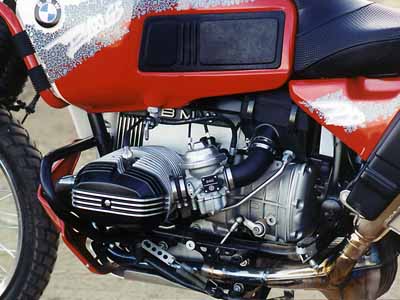 I stopped typing and called him. "Are you
SERIOUS?" He was. At this
point it was around 3:00 PM in California. I told him "I will be there
with a cashier's check in the morning, the bike is sold." The
next
morning, I had a one-way ticket from Burbank to Salt Lake City. I
checked in with my Hein Gericke Dakar jacket (what else?) and Shoei
helmet--no luggage. A flight to Salt Lake and short shuttle-bus ride
got me to Park City. After meeting, we took a quick ride to his house
for an obligatory glance at the bike before doing the papers (I thought
I should ACTUALLY see it before signing the papers). After exchanging
funds and papers at his bank, we had lunch under the trees in a nice
outdoor cafe overlooking the surrounding mountains. Preparations were
underway for the upcoming Winter Olympics and construction was
everywhere. I departed Park City at 2:30 PM, only 23 hours from
receiving his email offering the bike to me. I rode straight through to
Palmdale, 650 miles and arrived home at 1:30 AM. She was mine, the bike
I had wanted for so long.
I stopped typing and called him. "Are you
SERIOUS?" He was. At this
point it was around 3:00 PM in California. I told him "I will be there
with a cashier's check in the morning, the bike is sold." The
next
morning, I had a one-way ticket from Burbank to Salt Lake City. I
checked in with my Hein Gericke Dakar jacket (what else?) and Shoei
helmet--no luggage. A flight to Salt Lake and short shuttle-bus ride
got me to Park City. After meeting, we took a quick ride to his house
for an obligatory glance at the bike before doing the papers (I thought
I should ACTUALLY see it before signing the papers). After exchanging
funds and papers at his bank, we had lunch under the trees in a nice
outdoor cafe overlooking the surrounding mountains. Preparations were
underway for the upcoming Winter Olympics and construction was
everywhere. I departed Park City at 2:30 PM, only 23 hours from
receiving his email offering the bike to me. I rode straight through to
Palmdale, 650 miles and arrived home at 1:30 AM. She was mine, the bike
I had wanted for so long.
The BMW's Journeys
Cifu
Motorsports Home / Motorcycles /
BMW R100GS/PD


 In the 1980, BMW began an unlikely
assosiation with the Paris Dakar Rally.
At that time, the then 2 year old rally had been dominated by some
rather uncommon machines: hand prepared BMW Airhead boxers. The demands
of the Sahara were too great for the average dirt bike of the time.
What was needed to win was a stone reliable machine with great range.
To answer that question, teams prepared motorcycles that were largely
stock, right down to their factory Bing or Dellorto carburetors. Yes,
they ran more efficient air cleaners and open exhausts but power does
not win Dakar, reliability and consistent performance does. The frames
were reinforced, swingarms were lengthened and long travel shocks
installed. The best forks and brakes of the day were pulled from KTM
motocross bikes and installed on the BMW desert sleds. To finish the
machine off, huge fuel tanks were fitted. Some of these hand hammered
aluminum tanks held more than 11 gallons (US) of fuel. Of course the
well known BMW shaft drive was largely impervious to the 5000+ miles of
sand each machine would face. Yes, it was heavy but it was stone
reliable and easy to maintain and that's what it took to win Dakar.
Gaston Rahier and others rode these beasts to win after win. Yes, other
bikes were faster or lighter but in the end, the reliability and the
comfortable pace maintained by the BMW's eventually dominated.
In the 1980, BMW began an unlikely
assosiation with the Paris Dakar Rally.
At that time, the then 2 year old rally had been dominated by some
rather uncommon machines: hand prepared BMW Airhead boxers. The demands
of the Sahara were too great for the average dirt bike of the time.
What was needed to win was a stone reliable machine with great range.
To answer that question, teams prepared motorcycles that were largely
stock, right down to their factory Bing or Dellorto carburetors. Yes,
they ran more efficient air cleaners and open exhausts but power does
not win Dakar, reliability and consistent performance does. The frames
were reinforced, swingarms were lengthened and long travel shocks
installed. The best forks and brakes of the day were pulled from KTM
motocross bikes and installed on the BMW desert sleds. To finish the
machine off, huge fuel tanks were fitted. Some of these hand hammered
aluminum tanks held more than 11 gallons (US) of fuel. Of course the
well known BMW shaft drive was largely impervious to the 5000+ miles of
sand each machine would face. Yes, it was heavy but it was stone
reliable and easy to maintain and that's what it took to win Dakar.
Gaston Rahier and others rode these beasts to win after win. Yes, other
bikes were faster or lighter but in the end, the reliability and the
comfortable pace maintained by the BMW's eventually dominated. To celebrate this achievement, BMW built Paris
Dakar commemoritave
bikes beginning in 1981. Labled the BMW R80GS, the bike featured white
paint and a color scheme strangely reminescent of the rally bikes. It
was basically a doctored R80 with longer travel suspension and high
fenders. It also featured an uncommon feature for the day: a single
sided swingarm. Labled the "MonoLever" it housed the ring & pinion
in the right side of the swingarm. On the opposite side of the wheel,
three lug bolts secured the wheel to the ring gear. The GS didn't
really offer more fuel capacity or serious off-road capability but just
as the 1975 GL1000 Gold Wing accidentally became the touring standard,
the little GS invented a new segment of the market previously ignored:
Adventure Touring. Imagine touring for days on paved roads, only to see
a gravel road meanering off into the mountains--a gravel road you don't
dare take your plastic wrapped touring barge onto. That's the market
the R80GS was destined to dominate.
To celebrate this achievement, BMW built Paris
Dakar commemoritave
bikes beginning in 1981. Labled the BMW R80GS, the bike featured white
paint and a color scheme strangely reminescent of the rally bikes. It
was basically a doctored R80 with longer travel suspension and high
fenders. It also featured an uncommon feature for the day: a single
sided swingarm. Labled the "MonoLever" it housed the ring & pinion
in the right side of the swingarm. On the opposite side of the wheel,
three lug bolts secured the wheel to the ring gear. The GS didn't
really offer more fuel capacity or serious off-road capability but just
as the 1975 GL1000 Gold Wing accidentally became the touring standard,
the little GS invented a new segment of the market previously ignored:
Adventure Touring. Imagine touring for days on paved roads, only to see
a gravel road meanering off into the mountains--a gravel road you don't
dare take your plastic wrapped touring barge onto. That's the market
the R80GS was destined to dominate. 1990 was to see the introduction of an official
"Paris Dakar"
conversion kit. This kit included a 9.0 gallon nylon fuel tank, a steel
'roo-bar' around a new fixed headlight assembly and instrument cluster
with tachometer. Underneath, larger, vented skid plates attached to
both the engine and the centerstand. A plastic fender
extension--looking every bit like a childs sand shovel--added length to
the front fender. Later in 1990, BMW began offering the 'kit' on
factory motorcycles and labled it the R100GS/Paris Dakar. The factory
bikes also included the factory BMW hard bags as standard equpment, as
well as heated grips.
1990 was to see the introduction of an official
"Paris Dakar"
conversion kit. This kit included a 9.0 gallon nylon fuel tank, a steel
'roo-bar' around a new fixed headlight assembly and instrument cluster
with tachometer. Underneath, larger, vented skid plates attached to
both the engine and the centerstand. A plastic fender
extension--looking every bit like a childs sand shovel--added length to
the front fender. Later in 1990, BMW began offering the 'kit' on
factory motorcycles and labled it the R100GS/Paris Dakar. The factory
bikes also included the factory BMW hard bags as standard equpment, as
well as heated grips. And so it was that the year 2000 was to find my
beloved 1988 R100GS twisted up
in the
garage: the victim of "turned left in from the motorcycle
and never saw him coming." Yes, after lovingly putting my Bumblebeemer
back on the road and literally one week from her maiden voyage to Death
Valley, she was totalled. I didn't fare much better, suffering a
shattered ankle, banged up wrist, bruised ribs and an assortment of
other battle scars. The morning after the accident, I was on the phone
trying to find a Dakar conversion kit. I was determined to rebuild the
Bumblebeemer to better than new. After much searching, I had to concede
that no kits were available. The gas tanks had been long-since been
bought up by owners wishing to convert their standard model GS's to
PD's. Since the last PD rolled off the assembly line in 1995, it was
unlikely that spares were still floating around.
And so it was that the year 2000 was to find my
beloved 1988 R100GS twisted up
in the
garage: the victim of "turned left in from the motorcycle
and never saw him coming." Yes, after lovingly putting my Bumblebeemer
back on the road and literally one week from her maiden voyage to Death
Valley, she was totalled. I didn't fare much better, suffering a
shattered ankle, banged up wrist, bruised ribs and an assortment of
other battle scars. The morning after the accident, I was on the phone
trying to find a Dakar conversion kit. I was determined to rebuild the
Bumblebeemer to better than new. After much searching, I had to concede
that no kits were available. The gas tanks had been long-since been
bought up by owners wishing to convert their standard model GS's to
PD's. Since the last PD rolled off the assembly line in 1995, it was
unlikely that spares were still floating around. I stopped typing and called him. "Are you
SERIOUS?" He was. At this
point it was around 3:00 PM in California. I told him "I will be there
with a cashier's check in the morning, the bike is sold." The
next
morning, I had a one-way ticket from Burbank to Salt Lake City. I
checked in with my Hein Gericke Dakar jacket (what else?) and Shoei
helmet--no luggage. A flight to Salt Lake and short shuttle-bus ride
got me to Park City. After meeting, we took a quick ride to his house
for an obligatory glance at the bike before doing the papers (I thought
I should ACTUALLY see it before signing the papers). After exchanging
funds and papers at his bank, we had lunch under the trees in a nice
outdoor cafe overlooking the surrounding mountains. Preparations were
underway for the upcoming Winter Olympics and construction was
everywhere. I departed Park City at 2:30 PM, only 23 hours from
receiving his email offering the bike to me. I rode straight through to
Palmdale, 650 miles and arrived home at 1:30 AM. She was mine, the bike
I had wanted for so long.
I stopped typing and called him. "Are you
SERIOUS?" He was. At this
point it was around 3:00 PM in California. I told him "I will be there
with a cashier's check in the morning, the bike is sold." The
next
morning, I had a one-way ticket from Burbank to Salt Lake City. I
checked in with my Hein Gericke Dakar jacket (what else?) and Shoei
helmet--no luggage. A flight to Salt Lake and short shuttle-bus ride
got me to Park City. After meeting, we took a quick ride to his house
for an obligatory glance at the bike before doing the papers (I thought
I should ACTUALLY see it before signing the papers). After exchanging
funds and papers at his bank, we had lunch under the trees in a nice
outdoor cafe overlooking the surrounding mountains. Preparations were
underway for the upcoming Winter Olympics and construction was
everywhere. I departed Park City at 2:30 PM, only 23 hours from
receiving his email offering the bike to me. I rode straight through to
Palmdale, 650 miles and arrived home at 1:30 AM. She was mine, the bike
I had wanted for so long.